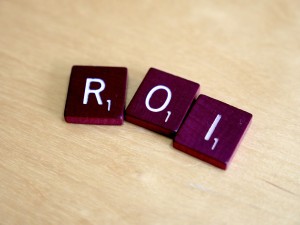
Image courtesy of LendingMemo
Not all returns from your customer experience investments are financial. Will that scare your executives?
One of the most-frequently-asked questions we hear from companies about listening to customers and, hence, improving the customer experience is: “How can I show ROI for my executives?” It’s a fair question, as improvements often require financial investments, and yet, at the same time, it makes me scratch my head. If the fear is that financial investments to improve the customer experience compete with other budget line items – are those other line items winning business, keeping customers, or driving more revenue?
Why don’t executives understand that the purpose of a business is to create a customer – and not just to create a customer but to also do whatever it takes to keep that customer. We need to forget about that 1970s mindset that the purpose of a business is to maximize shareholder value. That’s not a purpose; that’s an outcome of creating customers. Being customer-focused and customer-centric translates to shareholder value. Focus on the customer, on creating customers, and the profits will come.
But, I digress. Back to the original question. How can I show ROI for my executives? There are two ways:
- You can take someone else’s data and research and show “here’s what everyone else can do,” or
- You can build your own business case.
Let me start with the first one, sharing research that others have conducted. This is a good first step that allows you to educate your executives on the benefits of the customer experience. There are a ton of statistics out there on this topic, but a couple of reports that I regularly lean on that nicely summarize ROI include:
- Watermark Consulting’s annual research that compares Forrester’s Top 10 Customer Leaders and Bottom 10 Customer Laggards against the S&P 500 for the last seven years. Leaders outperformed the market, with a total return that was 26 points higher than the S&P 500, while Laggards underperformed (by 54 points!) to the point of a negative return!
- Temkin Group’s annual report on the ROI of Customer Experience states that the customer experience influences likelihood to purchase, recommend, forgive a company for mistakes, and try new offerings right away.
Again, there are a lot of metrics out there to support the importance of delivering a great customer experience. Feel free to reach out to me, and I’ll be happy to share those with you. But what about that second approach to showing ROI, building your own business case? This requires some work on your end.
When it comes to building your business case, there are a few things to remember. You’ll want to identify your overall program/CX objectives first and then align the business outcomes and benefits tied to each. Clearly, the stronger the business case, the better. Your outcomes may be customer retention, account growth, new business through referrals, culture change, etc. Benefits might include cost savings and other efficiencies. Communicate objectives, outcomes, and benefits to gain buy-in.
Building your business case is also about teaching – teaching executives who might not understand the connection between focusing on the customer experience and increasing revenue and profits.
One of the ways to do this is to show some quick wins or proofs of concept. Why? Because success breeds success. Everyone wants on that bandwagon. This means there will likely be some skunkworks (unsanctioned projects, of course) – or perhaps bootstrapped efforts – to create those small wins. A lot of our clients start with listening in one area, oftentimes the call center, and showing how listening and using the feedback to fix issues and inefficiencies to improve the experience leads to satisfaction, retention, cost savings, revenue growth, and profitability.
One important thing to note is that not all benefits realized or value delivered are financial. At least not immediately – some are emotional (feel good/security) or functional (convenience, choice, speed) benefits. That doesn’t make them any less important because (a) that may be what is most important to your customers and (b) down the road, those emotional and functional benefits can and will translate into financial benefits.
Without a doubt, if you focus on the customer experience and all that that entails, and if you build a community of raving fans, the business will thrive. Do you need examples? Just think about Apple, Nike, Google, Harley Davidson, Ritz-Carlton, Zappos, Disney, Nordstrom, Starbucks, and more – all of the cult brands. As I’ve mentioned many times before, here’s what that affords you; raving fans who…
- want to see the brand succeed and grow
- are happy to provide feedback, good or bad, to ensure that that success happens
- are less price sensitive
- require less support because they are more familiar with your products
- choose your brand over the competition
- can’t live without your brand and accept no substitutes
- are advocates or, even stronger, evangelists, spreading the word about your brand
- wear your brand, and want to show that they are part of something bigger than themselves
- openly recruit new members to the community
- are more likely to be using several of your products/services, not just one
- care about each other, want to help each other
- feel like they belong to something bigger than themselves (think “tribe”)
- wait in line – long lines, early morning lines – to buy your products
- elevate your brand, affording you favorable placement in stores and more
Those are, in a nutshell, the economics of a great customer experience. Do your executives need to hear more than that to get started?
An investment in knowledge pays the best interest. – Benjamin Franklin
This article was syndicated from Business 2 Community: The Economics of the Customer Experience
More Sales & Marketing articles from Business 2 Community:




